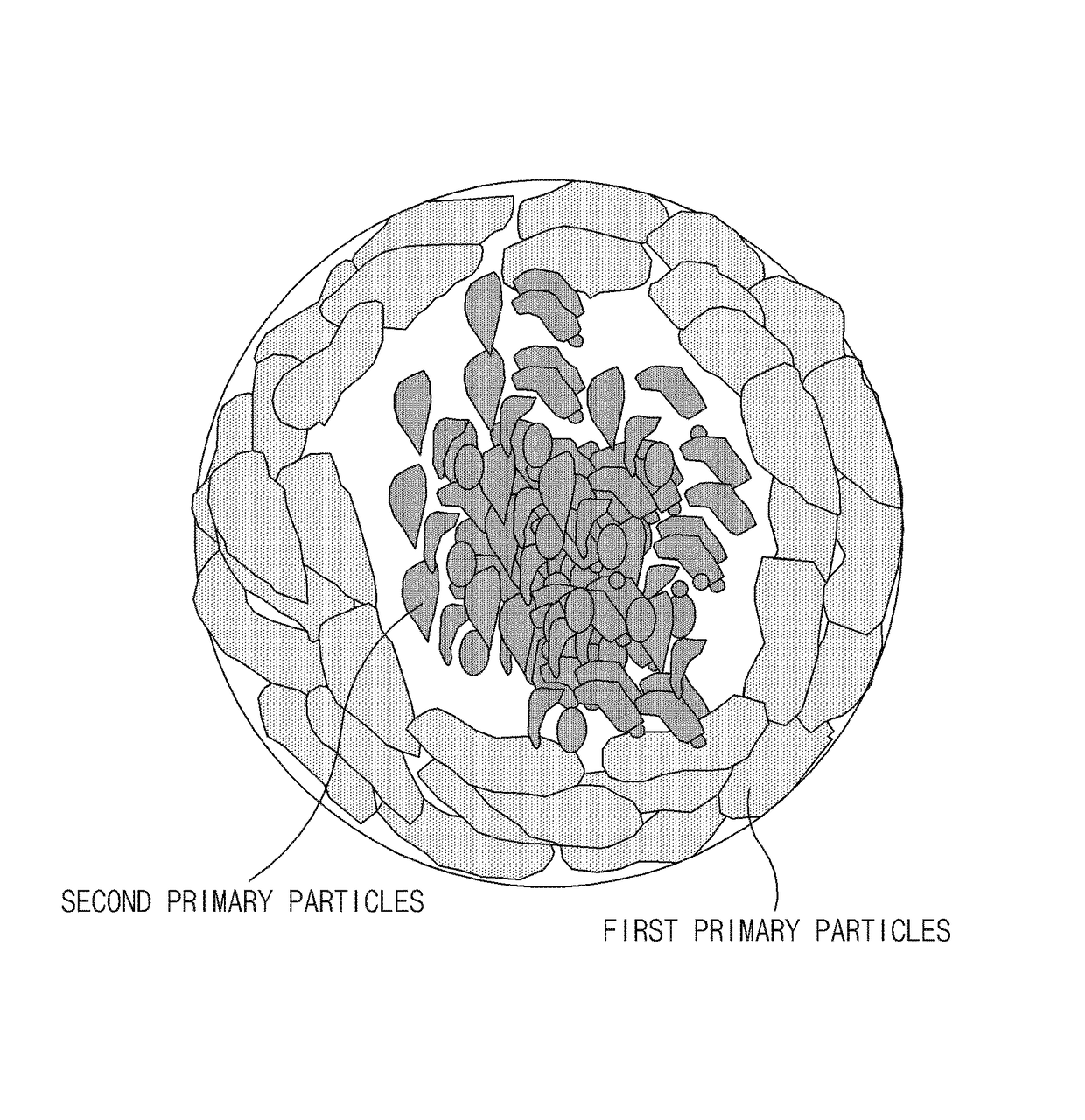Cathode active material including lithium transition metal phosphate particles, preparation method thereof, and lithium secondary battery including the same
a lithium transition metal phosphate and active material technology, applied in the manufacture of electrodes, cell components, electrochemical generators, etc., can solve the problems of low safety of lithium phosphate, poor cycle characteristics, and high cost of lithium phosphate, so as to increase the available capacity, high output characteristics, and performance characteristics
- Summary
- Abstract
- Description
- Claims
- Application Information
AI Technical Summary
Benefits of technology
Problems solved by technology
Method used
Image
Examples
example 1
Step (i) Preparation of Second Secondary Particles
[0136]A mixed solution was prepared in which ammonia water was added to a mixture of 1.5 mole of lithium aqueous solution (LiOH.H2O) and a ferrous sulfate aqueous solution containing 0.5 mole of iron sulfate (FeSO4.7H2O), 0.55 mole of phosphoric acid (P2O5), and an antioxidant to adjust a pH value in a range of 5.5 to 7. The mixed solution was introduced at a constant rate through a continuous supercritical reactor under conditions of a temperature of about 375° C. to about 450° C. and a pressure of 250 bar to 300 bar to prepare a LiFePO4 solution as lithium iron phosphate during a reaction time of a few seconds.
[0137]The LiFePO4 solution was filtered to obtain lithium iron phosphate particles. Purity of the lithium iron phosphate particles was analyzed by x-ray diffraction (XRD) analysis and primary particles were analyzed by a scanning electron microscope (SEM).
[0138]The washed lithium iron phosphate was reslurried in distilled wat...
example 2
Cathode Preparation
[0150]A cathode active material composition was prepared by adding 90 wt % of the cathode active material prepared in Example 1, 5 wt % of carbon black as a conductive agent, and 5 wt % of polyvinylidene fluoride (PVdF) as a binder to N-methyl-2-pyrrolidone (NMP) as a solvent. An about 20 μm thick aluminum (Al) thin film as a cathode collector was coated with the cathode active material composition and dried, and the Al thin film was then roll-pressed to prepare a cathode.
[0151]Anode Preparation
[0152]An anode active material composition was prepared by mixing 96.3 wt % of carbon powder as an anode active material, 1.0 wt % of super-p as a conductive agent, and 1.5 wt % of styrene-butadiene rubber (SBR) and 1.2 wt % of carboxymethyl cellulose (CMC) as a binder, and adding the mixture to NMP as a solvent. A 10 μm thick copper (Cu) thin film as an anode collector was coated with the anode active material composition and dried, and the Cu thin film was then roll-press...
experimental example 1
Charge and Discharge Characteristics
[0158]Charge and discharge characteristics of the lithium secondary batteries obtained in Example 2 and Comparative Example 2 were measured. In the initial 6th cycle, the lithium secondary batteries prepared in Example 2 and Comparative Example 2 were charged at 0.2 C to 4.2 V under constant current / constant voltage (CC / CV(2%)) conditions. Thereafter, the lithium secondary batteries were discharged at a CC of 2.0 C to a voltage of 2.5 V vs. Li / Li+, and the charge and discharge were then terminated. The results thereof are presented in Table 2 below.
PUM
| Property | Measurement | Unit |
|---|---|---|
| particle diameter | aaaaa | aaaaa |
| particle diameter | aaaaa | aaaaa |
| average particle diameter | aaaaa | aaaaa |
Abstract
Description
Claims
Application Information
 Login to View More
Login to View More - R&D
- Intellectual Property
- Life Sciences
- Materials
- Tech Scout
- Unparalleled Data Quality
- Higher Quality Content
- 60% Fewer Hallucinations
Browse by: Latest US Patents, China's latest patents, Technical Efficacy Thesaurus, Application Domain, Technology Topic, Popular Technical Reports.
© 2025 PatSnap. All rights reserved.Legal|Privacy policy|Modern Slavery Act Transparency Statement|Sitemap|About US| Contact US: help@patsnap.com

